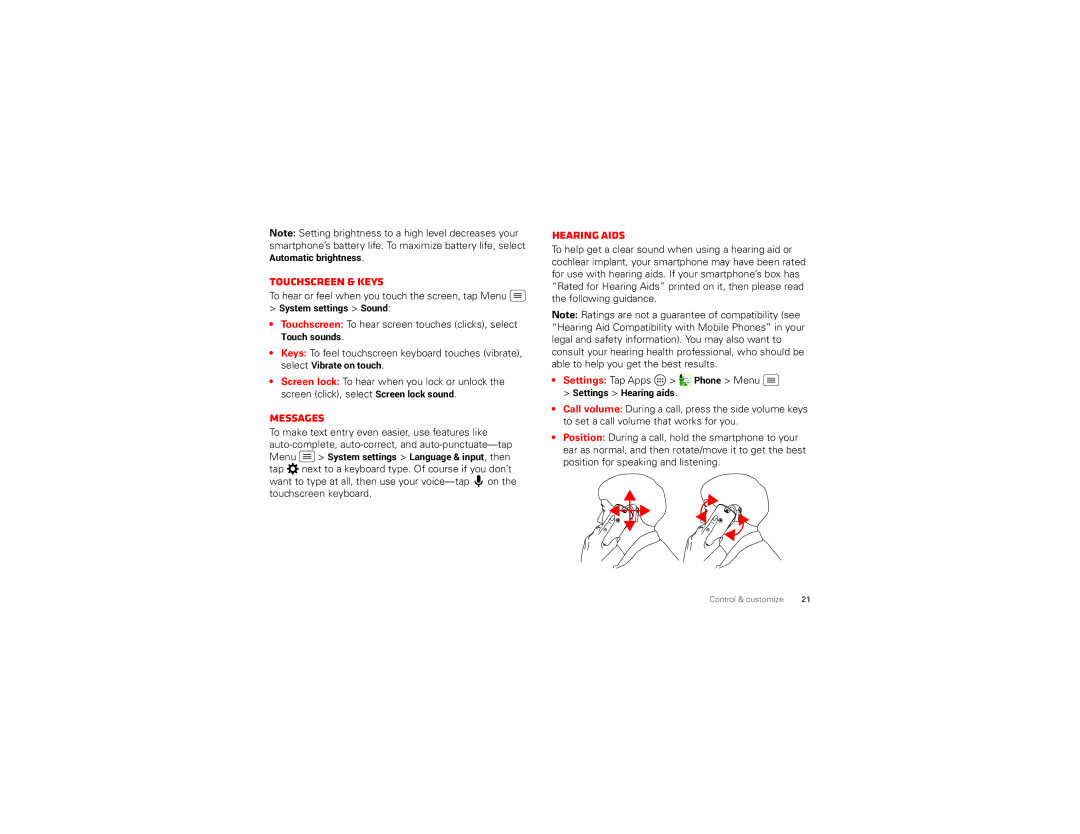User’s Guide
Page
Check it out
Contents
More All the topics in this guide and so much more
At a glance
Your smartphone
Insert micro SIM Insert microSD card
Assemble & charge battery
Start
Top topics
Add actions
Battery life
System settings Battery
Register
Display brightness Tap Menu System settings
Display timeout delay Tap Menu System settings
Display Brightness Display power saver
Music
Best of Google
Download Google apps Tap Apps Play Store
Old phone to new phone
All in the cloud See Your cloud on
Status & Notifications
Home screen & apps
Quick start Home screen & apps
Redecorate your home
Search your apps, contacts, files, places, and the web
Help
Search
Google Now
Service, tap Search to open the search window, then
Tap Menu Settings Google Now
Status & notifications
Help To get help and more, tap Menu
Download apps
Google Play
Apps from the web
Share, show, or clear app details Tap Menu
Uninstall apps Tap Menu System settings
Take Care of your apps
Choose carefully
Update your smartphone
Quick start Control & customize
Control & customize
Touch
On, off, lock & unlock
Press
Power key
Volume keys
Dialing and commands Tap Search , then
Customize your smartphone’s sounds and appearance
Display settings To change brightness, animation
Customize
Help
Settings, and uncheck Suggestion notifications
For help with the Smartactions app, tap Menu
SmartActions
Explore by touch
Accessibility
Voice recognition
TalkBack
Display brightness
Volume & vibrate
Caller ID
Zoom
Hearing aids
To hear or feel when you touch the screen, tap Menu
Touchscreen & keys
Messages
Phone
Calls
Quick start Calls
Apps
End a call Tap
Make, answer & end calls
Multi-task Tap Home
Handsfree
Recent calls
Phonebook
Voice dial
Video chat
Mute
Enter numbers during a call
Voicemail
Enter the emergency number Tap to call the emergency number
Contacts
Emergency calls
Quick start Contacts
Edit, delete, or hide contacts
Create contacts
Call, text, or email contacts
Favorite contacts
To hide the contacts from an account or group in your
Get contacts
Share contacts
Groups
Quick start Messages
Tip When the screen is locked, tap and flick
Messages
My details
Create text messages
Settings Tap Menu
Read, reply, forward & delete text messages
Change or delete accounts To change Gmail
Corporate, and enter details from your IT administrator
Insert a quick response When composing an email
Quick responses
Start a voice or video chat Tap the voice or
Wireless Emergency Alerts
Chat
Swype Keyboard
Type
Quick start Type
Close the keyboard Tap Back
Cut, copy & paste
Text entry settings & dictionary
To choose your display keyboard, tap Default
Find it Tap Menu System settings Language & input
Photos. To delete the circle, tap Menu Delete circle
Socialize
Quick start Socialize
Drop-down list to show the circle’s Posts
Create or open bookmarks Open the address bar
Browse
Other social networks
Quick start Browser
Standard computer versions of all websites, tap
Web connection
Bookmarks
Downloads
Keep track of what your browser and searches show
Browser history, cache, and passwords To clear
Browser options
Safe surfing & searching
Choose history, cache, cookies, and other options
Settings Privacy Clear Browsing DATA. Then
Quick start Chrome
Drag down, then tap Menu or Bookmarks
Camera
Photos & videos
Quick start Photos & Videos
Memory card Photos and videos are stored in your
Perfect shot
Take photos
Record videos
Wallpaper or contact
Edit, share, or delete photos & videos
Or these video options
Find it Tap Apps Gallery
Screenshots
Capture your screen
Movies & TV on Google Play
YouTube
Quick start Music
Music on Google Play
Quick start Books
Books on Google Play
Find nearby businesses or attractions Tap
Locate & navigate
Quick start Locate & navigate
Find an address Tap
To remove friends, tap next to their name
Google Local
Google Maps Navigation beta
Google Latitude
Corporate sync
Work
Quick start Work
Office network
Alarm
Find it Tap Apps Clock Set alarm
Menu System settings Date & time
To go to today’s date, tap at the top of the screen
Quick start Webtop
Smart Transitions from smartphone to WEBtop
Connect
Controls
Computer. To change the type of USB connection, tap
Connect accessories, computers, networks, and more
Connect & transfer
Quick start Connect & transfer
Manage devices
Bluetooth wireless
Turn Bluetooth power on/off
Connect devices
Transfer files
Wi-Fi Networks
Wi-Fi enhanced connectivity
Turn Wi-Fi power on/off
MotoCast
Wi-Fi hotspot
Wi-Fi modes
Smartphone setup Tap Menu System settings
Remove or erase a memory card
Memory card & file management
USB cables
Manage files on your smartphone
USB tethering to start the connection
Share your data connection
Data use
USB connection
Limit, you can also turn off background data use. Just
Your cloud
Sync your Google account
Restrict all background data After you set a data use
Search Directions Local Layers Menu
Smartphone & tablet
Google Drive
Upload from your smartphone Tap Menu
Mobile network
Dlna media devices
Virtual Private Networks VPN
Quick start Protect
Airplane mode
Airplane mode
Protect
Face unlock Unlock your smartphone by looking at it
Find it Tap Menu System settings Security
Screen lock
Can’t unlock?
SIM lock
Backup & restore
Reset
To reset your smartphone to factory settings and erase all
Want more?
Troubleshooting
Crash recovery
Service & repairs
Been damaged in any of the ways listed here
Battery Use & Safety
Battery Charging
Repetitive Motion
Third Party Accessories
Driving Precautions
Seizures, Blackouts & Eyestrain
Radio Frequency RF Energy
SymbolDefinition
Glass Parts
Operational Warnings
European Union Directives Conformance Statement
Specific Absorption Rate FCC & IC
Software Notices
Location Services
FCC Notice to Users
Industry Canada Notice to Users
Privacy & Data Security
Navigation
Hearing Aid Compatibility with Mobile Phones
Use & Care
Recycling
California Perchlorate Label
Export Law Assurances
Content Copyright
Software Copyright
Open Source Software Information
Product Registration
Service & Repairs
Motorola Mobility LLC Limited Global Warranty Mobile Phones
What Will Motorola Do?
This warranty does not apply to
What Other Limitations are There?
Copyright & Trademarks

